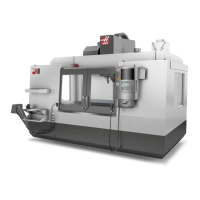6
96-0041 Rev U
July 2010
Machine Productivity
Use the load meter as an indicator of how the machine is cutting. Speeds and
feeds should be adjusted after the initial cut. The initial cut will give an instant
read-out of the performance of the machine. If adjustment are necessary, they
should be made in 10% increments. Pay close attention to:
• Chip formation and color
• Chip load
• Monitor part and xture during the cut
• Listen for any unusual noises
Surface Finish
A good nish depends on a number of variables. The following are a number of
items to check to achieve a good nish:
• Good nish results in slower feeds and higher speeds
• Face milling produces the best nish
• Increasing the number of cutters (inserts) allow for a better nish
• Cuts should always be in the same direction
• Lighter depth of cuts will produce a better nish
• Coolants use can also affect part nish
Accuracy
Machine accuracy can be affected by a number of variables, such as:
Is the machine properly warmed up?
Holes should be center drilled rst
Check the condition of the tooling
Cutting Tool Descriptions
Drill Used to create a cylindrical hole in a work piece. Drilled holes can be
“through holes” or “blind holes”. A “blind hole” is not cut entirely through a work
piece.
Center drill A small drill with a pilot point. It is used to create a small hole with
tapered walls. When a hole’s location must be held to a close tolerance, use a
center drill rst and then use a regular drill to nish the hole. The tapered walls
of the center-drilled hole will keep the regular drill straight when it begins to drill
into the work piece.
Reamer Designed to remove a small amount of material from a drilled hole.
The reamer can hold very close tolerance on the diameter of a hole, and give a
superior surface nish. The hole must be drilled rst, leaving .005 to .015 of an
inch stock on the walls of the hole for the reamer to remove.
Tap Used to create screw threads inside of a drilled hole. NOTE: Care must
be taken when using a milling machine to perform a tapping operation. For
example, the spindle speed and feed must be synchronized.
End Mill Shaped similar to a drill, but with a at bottom (end). It is used primar-
ily to cut with the side of the tool, to contour the shape of a work piece.

